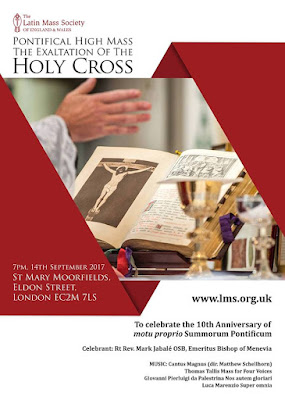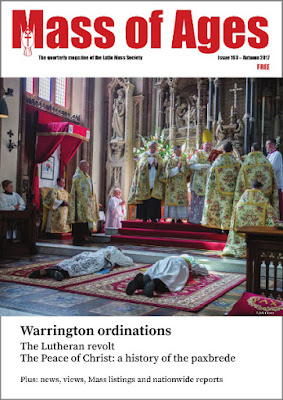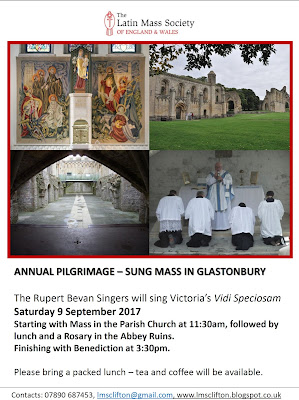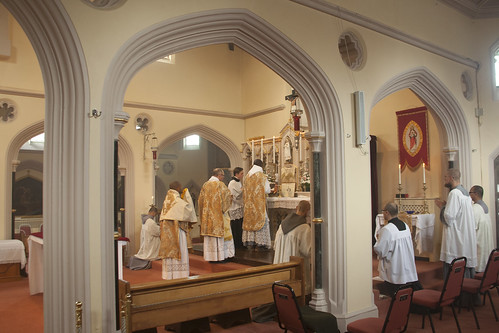Chairman's Blog
Irreversible reform? Me in the Catholic Herald this weekend
This weekend the Catholic Herald has a cover story about the Traditional Mass' appeal to young people, by Matthew Schmitz.
Accompanying this is a shorter piece by me on Pope Francis' remarks, make in a speach to a group of Italian liturgists, that the 'reform' is 'irreversible'.
It is not available online, so you'll need to look out for a paper edition. Here's a taster.
Pope Francis’s recent address on the liturgy – about which he has hitherto said little – was striking for its conventionality. In almost every respect, the Pope’s speech hews to the official, post-Vatican II line. It emphasises the continuity of the post-conciliar reform with the efforts of Pius X and XII; it praises the reform for its “vitality”; it condemns liturgical abuses (“deformations”); and it calls for an end to liturgical conflict.
But it has raised eyebrows for its rejection of the possibility of revisiting the “decisions” of the reform in light of its “inspirational principles: an explicit rejection of the “Reform of the Reform” project, which seeks to go back to the Council documents and do the reform again, better. This should be no surprise. In the official mindset, the reform was perfect and was marred only by liturgical abuses. Liturgical progressives should note that the account of the liturgy which follows is entirely traditional, focusing on the altar, the Sacrifice of the Mass, and the Priesthood of Jesus Christ, not even mentioning the Last Supper, the Mass as a shared meal or the liturgy as an affirmation of community.
Pontifical Mass for the 10th Anniversary of Summorum Pontificum in London: 14th Sept
 Thursday 14th September, 7pm: Pontifical High Mass in St Mary Moorfields, Eldon Street EC2M7LS
Thursday 14th September, 7pm: Pontifical High Mass in St Mary Moorfields, Eldon Street EC2M7LSTo celebrate the 10th Anniversary of Summorum Pontificum, celebrated by Rt. Rev Mark Jabale OSB, Emeritus Bishop of Menevia.
Music by Cantus Magnus directed by Matthew Schellhorn:
Thomas Tallis (c. 1505 – 1585) Mass for Four Voices
Giovanni Pierluigi da Palestrina (c. 1525 – 1594) Nos autem gloriari
Luca Marenzio (c. 1553 – 1599) Super omnia
Kyrie XI
Support the work of the LMS by becoming an 'Anniversary Supporter'.
Crying rooms in churches: a terrible idea
 |
| Adults and children kneel for the Consecration at the St Catherine's Trust Summer School |
Last weekend's Catholic Herald carried an article by me about 'crying rooms', spaces sealed off with soundproof glass intended for noisy children and their parents.
I was inspired to write it by realising that the notion of excluding children from the rest of the congregation, or even from Mass entirely, was an idea with a following among not a few conservative and traditionally-minded Catholics. It is a reaction against the experience of chaotic liturgy where children are allowed to wander around, perhaps even into the sanctuary, which I suppose is more associated with a 'progressive' liturgical attitude. The thought would be: if we want a well-ordered, reverent liturgy, we need to get the small children under control; since we can't rely on parents to do this, we should bundle them into a separate space where they won't spoil things for everyone else.
This is short-sighted, however: as I explain the article, children won't learn to behave if shoved into a room where they can behave as badly as they like, and their parents won't learn to discipline them in that context either. Neither the parents nor the children will experience the atmosphere of the liturgy, and both are left with the impression that they are not truly welcome.
I have noted on this blog that another element in the anti-child mindset is the idea that children won't get anything out of the liturgy anyway because the liturgy has to be grasped intellecually in order to have any effect on the worshipper. This, of course, is absurd; indeed I fancy that few people who are influenced by this idea would actually agree with it when set out in black and white. But if it is false, then obviously children, and indeed infants, will benefit from the sacraments and blessings of the liturgy, which is of course why we get babies baptised.
Here's the beginning of the article.
To many people disturbed by children making a noise during Mass, “crying rooms” must seem like an answer to prayer. The children can just go in there, and the problem is solved.
Things look rather different from a parent’s perspective, however. If your noisy child goes into a crying room, with other noisy children, then you have to go as well, and quite probably your other children with you. The problem of the disturbance hasn’t actually been solved: it has been alleviated for most members of the congregation, and made much worse for others. If you haven’t had the incomparable experience of screaming babies in a confined space, you should try some long-haul flights in the holiday season.
Read it all there.
Support the work of the LMS by becoming an 'Anniversary Supporter'.
We're off to Walsingham!
This is a scheduled post: blogging from the road is very difficult. But please remember the Latin Mass Society pilgrims on the road to Walsingham, departing early Friday and arriving lunchtime on Sunday. After Mass in the Catholic Shrine, we walk the last, 'Holy Mile', to the site of the Medieval Shrine, arriving there at about 4:30pm, with many others who've come for the day.
Join us next year!
Support the work of the LMS by becoming an 'Anniversary Supporter'.
Moving Priests: Spetchley and Hethe
| Fr Anthony Talbot in the chapel at Spetchly Park |
Archbishop Longley is moving some priests around in his diocese, and this will effect the provision of the Extraordinary Form in two locations.
Fr Paul Lester is moving away from Holy Trinity, Hethe, and we wish the best in his new parish. He will be leaving on 10th September. It was entirely his initiative to start celebrating the Traditional Mass in the beautiful church of Holy Trinity, and to do so every Sunday, including most recently two Sung Masses a month, and the occasional High Mass with deacon and subdeacon. Among his other achievments as Parish Priest, Fr Lester arranged for Archbishop Longley to celebrate the EF in Holy Trinity, and celebrated Midnight Mass in the church each Christmas.
We are extremely grateful to him for all of this, which has been a tremendous benefit to many supporters of the EF in the area, and to many, indeed, who were able to discover it.
Fr Lester has been in Hethe only three years, but happily what he started will continue.
Fr Anthony Talbot will be moving away from Spetchley Park, where he has been chaplain in the private chapel there. His new role will include celebrating the Traditional Mass in Hethe.
It is a matter of regret that for the moment it would appear that regular Masses will no longer be taking place at Spetchley Park. However, we are very pleased that continuity of the EF at Hethe has been ensured, and I personally look forward to seeing Fr Talbot, a long-standing friend of Tradition, in Holy Trinity. We are very grateful to Archbishop Longley for bearing in mind the needs of the traditional faithful in Hethe, as he juggles his limited resources in his enormous diocese.
If there is a short gap between Fr Lester's departure and Fr Talbot's arrival in Hethe, the Latin Mass Society will do its best to arrange for the regular Sunday Masses at 12 noon to continue without a break.
Support the work of the LMS by becoming an 'Anniversary Supporter'.
Latin Mass Society Pilgrimage to Glasonbury 2017
The Latin Mass Society's annual Pilgrimage to Glastonbury will take place on Saturday 9th September.
It starts at 11:30am with Sung Mass in the Catholic Parish Church, St Mary's, Magdalene St, Glastonbury BA6 9EJ: click for a map.
This is directly opposite the ruins of the Abbey, and pilgrims will as usual have access to the Abbey grounds as part of the pilgrimage.
Support the work of the LMS by becoming an 'Anniversary Supporter'.
High Mass and Family Day at St Mary's Gosport
On Saturday 12th July I attended High Mass in St Mary's, Gosport, where the friars organised a 'family day', with some talks about matters of interest to Catholic families and activities for the children.
I gave a talk about the absence of men from the Church. But here are some photos of Mass.
The celebrant was Fr Pio, the deacon the Rev Stephen Morgan, and the subdeacon Fra Rosario.
Support the work of the LMS by becoming an 'Anniversary Supporter'.
Guild of St Clare: sewing workshops in Oxford
Well, strictly speaking these are in Headington, a suburb of Oxford. But everyone is welcome. Cross-posted from the Guild blog.
Forthcoming autumn events
2nd September: Project Finishing - bring along your unfinished sewing projects and make some progress with the help of our skilled Guild members!
21st October: Embroidery techniques with Jacqui McDonald of the Royal School of Needlework
11th November: Vestment mending and making - we have various altar furnishings, chasubles, and a cope in need of repair. Join us to assist us in mending them, learn about their construction and serve the Church.
All these workshops are taking place at St Anthony of Padua church hall, 115 Headley Way, Oxford OX3 7SS. They run between 10am and 4pm. Tea and cake is provided - please bring your own lunch. For more details or to book a place please email Lucy on lucyashaw@gmail.com.
Support the work of the LMS by becoming an 'Anniversary Supporter'.
Autumn Mass of Ages published
 Mass of Ages is the quarterly magazine of the Latin Mass Society. It contains reports on our many activities across the country, national and international news of Traditional Catholic events, feature articles on different aspects of traditional Faith and culture, and opinions and views on developments in the Catholic Church.
Mass of Ages is the quarterly magazine of the Latin Mass Society. It contains reports on our many activities across the country, national and international news of Traditional Catholic events, feature articles on different aspects of traditional Faith and culture, and opinions and views on developments in the Catholic Church.The autumn 2017 edition is now available. The cover article, History in the Making, is a report on the first Ordinations in the Traditional Rite in England for more than 50 years. Other features are Angels and devils, by Canon Amaury Montjean of the Institute of Christ the King Sovereign Priest on the writings of St Francis de Sales, Thirty years of the Old Rite, a history of the Traditional Mass on the Isle of Wight and The Peace of Christ, in which the LMS Chairman, Dr Joseph Shaw, looks at the history of the paxbrede.
• Alberto Carosa talks to Coetus Internationalis Summorum Pontificum Secretary, Guillaume Ferluc, about the forthcoming Summorum Pontificum Pilgrimage to Rome.
• Caroline Shaw looks at El Greco’s The Burial of the Count of Orgaz
• Mary O’Regan on the Third Secret of Fatima
• Paul Waddington, a Vice-President of the LMS, reports on the recent restoration of the wall paintings in the sanctuary and Lady Chapel of Sacred Heart, Caterham.
• Fr Bede Row asks, “Do we still believe in Angels?”
• The Lone Veiler on Holy Communion
Support the work of the LMS by becoming an 'Anniversary Supporter'.
Music and silence: how I hate them both!
fe
Reposted from February 2016
----------------------------------------------
So exclaimed Screwtape, the devil imagined by C.S. Lewis in his Screwtape Letters. Music and silence have a lot in common, and it is something which enrages the devil.
Matthew Schellhorn, pianist and the LMS Director of Music for London, is this week exploring the relationship between the two on the Catholic Herald website. Here's a taster.
January 2016 saw an appeal from Cardinal Sarah for a “high-quality liturgical renewal” involving silence as a fundamental component. We need to respect silence in the sacred liturgy as “a Christian ascetical value”, a “necessary condition for deep, contemplative prayer”. Sarah asks: “If our ‘interior cell phone’ is always busy because we are ‘having a conversation’ with other creatures, how can the Creator reach us, how can he ‘call us’?”
...
Should you require it, you can even buy a mobile app that allows you to listen to exactly four and a half minutes of silence on the go. (You really cannot make it up.) That is 2016 for you, but what is really revealing, however, is that Cage felt that his piece would be “incomprehensible in the Western context” when he “wrote” it in 1952. Because, funnily enough, four and a half minutes or so is about the time of absolute silence we experience during the Canon of the Mass in the Usus Antiquior, the traditional Latin Mass. In other words, this length of silence proposed by Cage to classical music audiences in the mid-twentieth century was of a length commonly experienced daily by millions in the Western world at that time.
But, sadly, it may be that silence in the Mass was not understood well enough for us to register its sheer normality and naturalness. TheCatholic Encyclopedia of 1908 gives us the “mystic reasons” for the profound four-and-a-half-minute silence in the traditional Mass. The silent prayers are “thus shown to be purely sacerdotal, belonging only to the priest, the silence increases our reverence at the most sacred moment of the Mass, removes the Consecration from ordinary vulgar use, and is a symbol of our Lord’s silent prayer in the Garden and silence during his Passion”. Moreover, “the Ordinary to the Sanctus, with its lessons, represents Christ’s public life and teaching; the Canon is a type of the Passion and death – hence it is said in silence. Christ taught plainly, but did not open his mouth when he was accused and suffered.”






